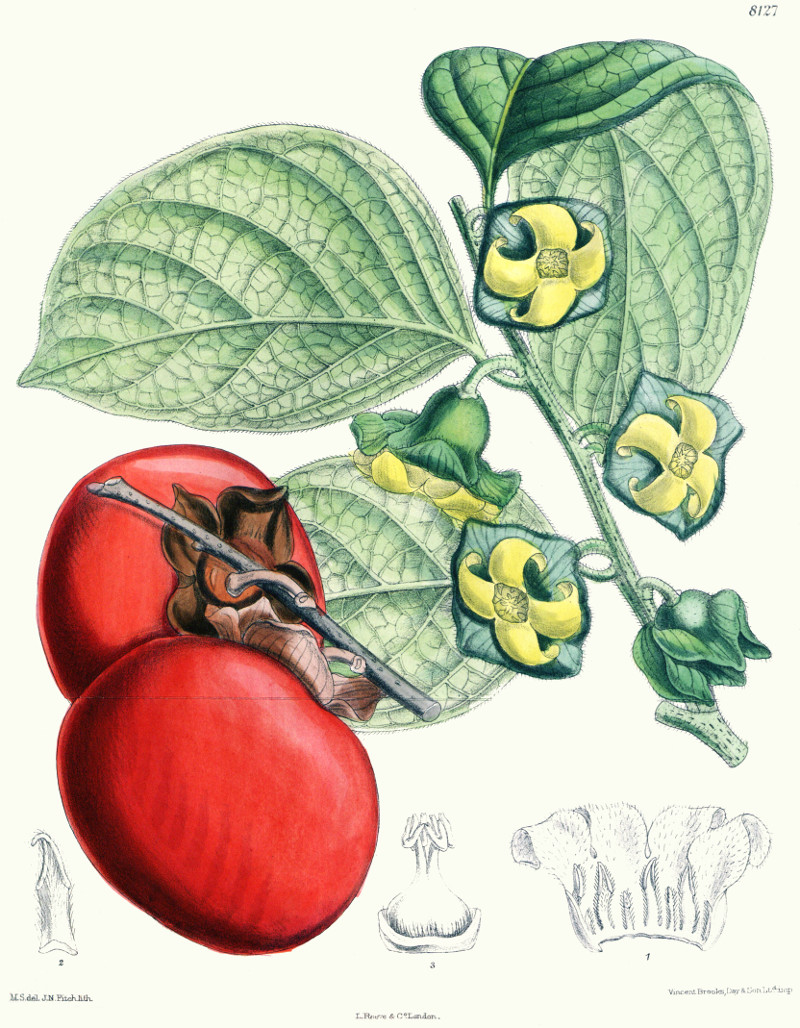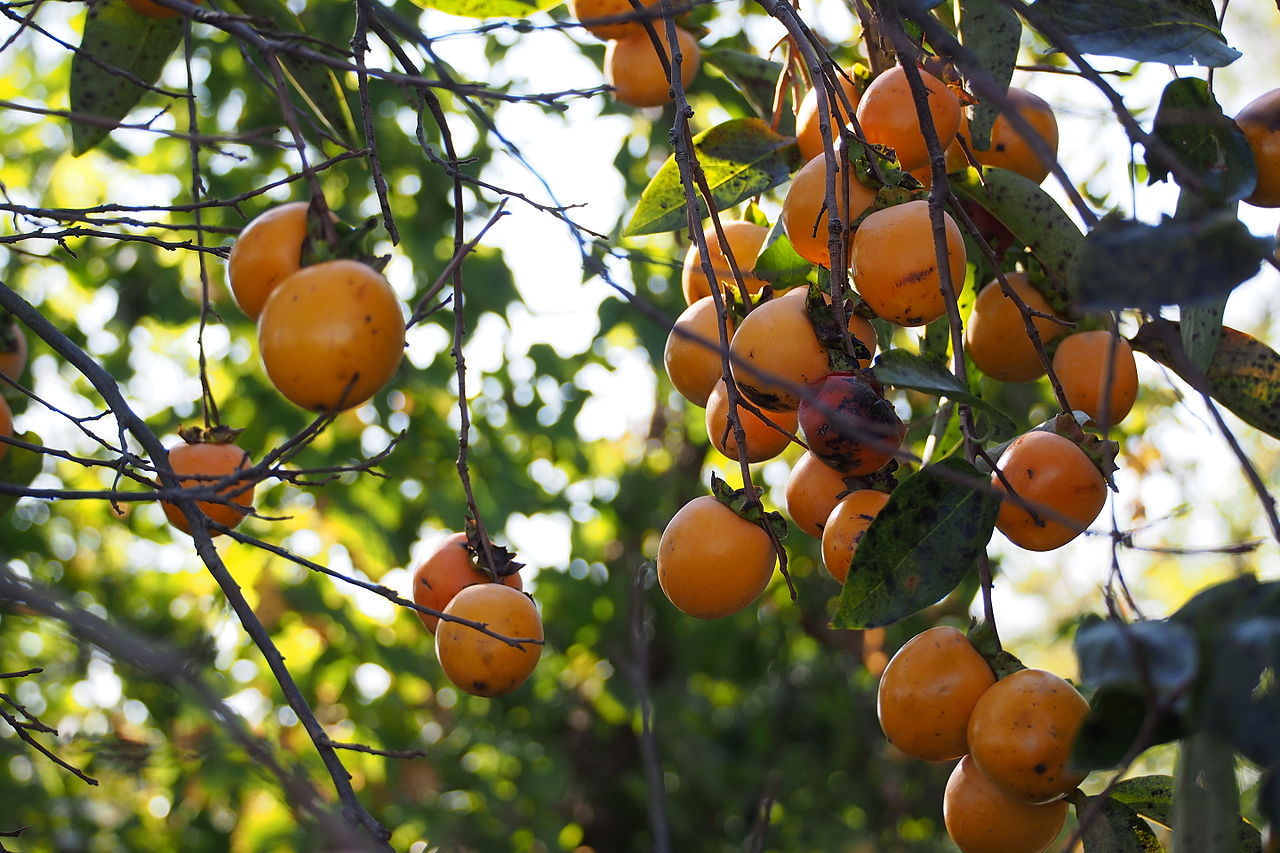Diospyros kaki Thunb. - Ebenaceae - 柿 shi (chin.), (Chinese, Japanese) persimmon, kaki, Kaki, Kakipflaume, Persimmon, Sharon
Deciduous fruit tree, native to China, Taiwan and Myanmar, naturalized in Japan, cultivated in East Asia, Middle East, Spain, Italy and Brazil; leaves lanceolate to ovate; flowers solitary, campanulate, yellowish white; fruits are berries, yellow to orange, flattened globose to ovoid, 3.5-8.5 cm in diameter.
http://www.efloras.org/florataxon.aspx?flora_id=2&taxon_id=200017585
„…known as the shizi (柿子 in Chinese), and also as the Japanese Persimmon or kaki (柿) in Japanese. It is the most widely cultivated species. Its fruits are sweet, and slightly tangy with a soft to occasionally fibrous texture. Cultivation of the fruit extended first to other parts of east Asia and Pakistan, and was later introduced to California and southern Europe in the 1800s, to Brazil in the 1890s,[6] and numerous cultivars have been selected. It is edible in its crisp firm state, but has its best flavor when allowed to rest and soften slightly after harvest… The fruit has a high tannin content which makes the immature fruit astringent and bitter. The tannin levels are reduced as the fruit matures. Persimmons like 'Hachiya' must be completely ripened before consumption. When ripe, this fruit comprises thick pulpy jelly encased in a waxy thin skinned shell…
„Sharon fruit“ (named after the Sharon plain in Israel) is the marketing name for the Israeli-bred cultivar 'Triumph'. As with all pollination-variant-astringent persimmons, the fruit are ripened off the tree by exposing them to carbon dioxide. The „sharon fruit“ has no core, is seedless, particularly sweet, and can be eaten whole.“ http://en.wikipedia.org/wiki/Persimmon
"Persimon®" ist the trade name of a seedless spanish cultivar.
„Postharvest biochemical changes were traced during astringency removal in persimmon fruit (Diospyros kaki). Fruit firmness, basic peel colour, soluble solids, concentration of ethanol, acetaldehyde, tannin, pectin, and sugars were measured. Fruit was kept in high carbon dioxide (100 %) for 20 hours at 20 °C. After 20 hours the fruit was kept in normal atmosphere at 20 °C for three days. During the astringency removal the concentration of ethanol and acetaldehyde rises, while the concentration of tannin lessens for all cultivars with the exception of cultivar 'Kaki Tipo'. To lose its astringency completely the cultivar 'Kaki Tipo' requires a prolonged period of high CO2 treatment (72 hours instead of 20 hours required for other examined cultivars).“
[Astringency removal by high CO2 treatment in persimmon fruit (Diospyros kaki). Vidrih, R., Simcic, M., Hribar, J., Plestenjak, A., In International Symposium on Postharvest Treatment of Horticultural Crops Vol.368 , 1993, 652-656)]
„Cold storage and removal of astringency effects on quality of persimmon fruit cv. Rojo brillante were determined. Persimmon fruit were stored at 1, 8, 11 and 15 ºC (85–90% RH) and after 6, 13, 20, 27 and 34 days of storage at these temperatures, astringency was removed. Fruit quality was assessed after the removal of the astringency and after a simulated retail storage period of 6 days at 20 ºC. Storage temperature affected fruit firmness, colour, appearance, acetaldehyde and ethanol production but not total soluble solids or flavour. Fruit stored at 15 ºC followed by 6 days at 20 ºC maintained the best commercial firmness and the lowest ethanol and acetaldehyde production. Chilling injury was observed after storage at 20 ºC on those fruits previously stored at 1 or 8 ºC.“
[Effect of Cold Storage and Removal Astringency on Quality of Persimmon Fruit (Diospyros kaki, L.) cv. Rojo Brillante., L. Arnal, M. A. Del RÌo, Food Science and Technology International, Vol.10(3), 2004, 179-185]
„Although persimmon fruit is grown in various countries and is increasingly appreciated for its nutritional value, health benefits and rich flavour, surprisingly little research has been conducted to uncover the components responsible for its unique flavour. An aroma extract of persimmon fruit (Diospyros kaki L., var. Triumph) was obtained by hydrodistillation under vacuum followed by solid phase extraction. Gas chromatography–mass spectometry (GC-MS) analysis of the extract led to the positive identification of 50 compounds, among which aldehydes emerged as the most important class of volatile compounds. Thirty-two compounds were determined to have aroma-impact, by gas chromatography–olfactometry analysis of the aroma extract. The six most intense aroma-impact compounds were methional, (E)-2-hexenal, phenylacetaldehyde, (E,Z)-2,6-nonadienal, hexanal and furaneol. Their aroma qualities largely explain the aroma character of persimmon fruit, which was described as fresh peach, a touch of orange, sweet, woody, floral, green and potato. Unambiguous identification of trace aroma-impact compounds (E,E,Z)-2,4,6-nonatrienal and (E,Z,Z)-2,4,7-decatrienal by GC-MS was achieved by applying a solid phase extraction procedure for selective isolation of carbonyl compounds.“
[Characterization of volatile and aroma‐impact compounds in persimmon (Diospyros kaki L., var. Triumph) fruit by GC‐MS and GC‐O analyses. Wang, Y., Hossain, D., Perry, P. L., Adams, B., Lin, J., Flavour and Fragrance Journal, Vol.27(2), 2012, 141-148]

Curtis’s Botanical Magazine, vol.133 [ser.4, vol.3] t.8127 (1907) [M.Smith]
http://plantgenera.org/species.php?id_species=346325

Japanese Persimmon (Diospyros kaki), Author harum.koh from Kobe city, Japan (2015)
CC BY-SA 2.0 Wikimedia Commons